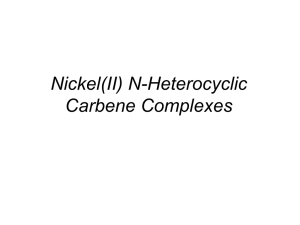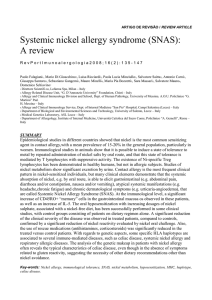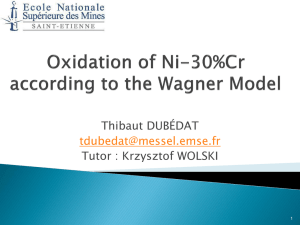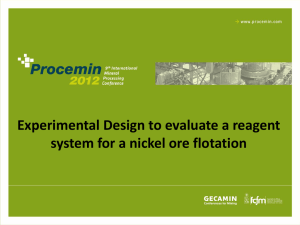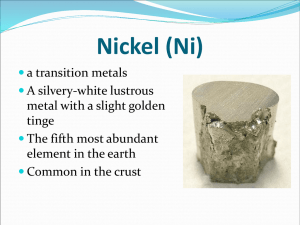CHEM56
advertisement
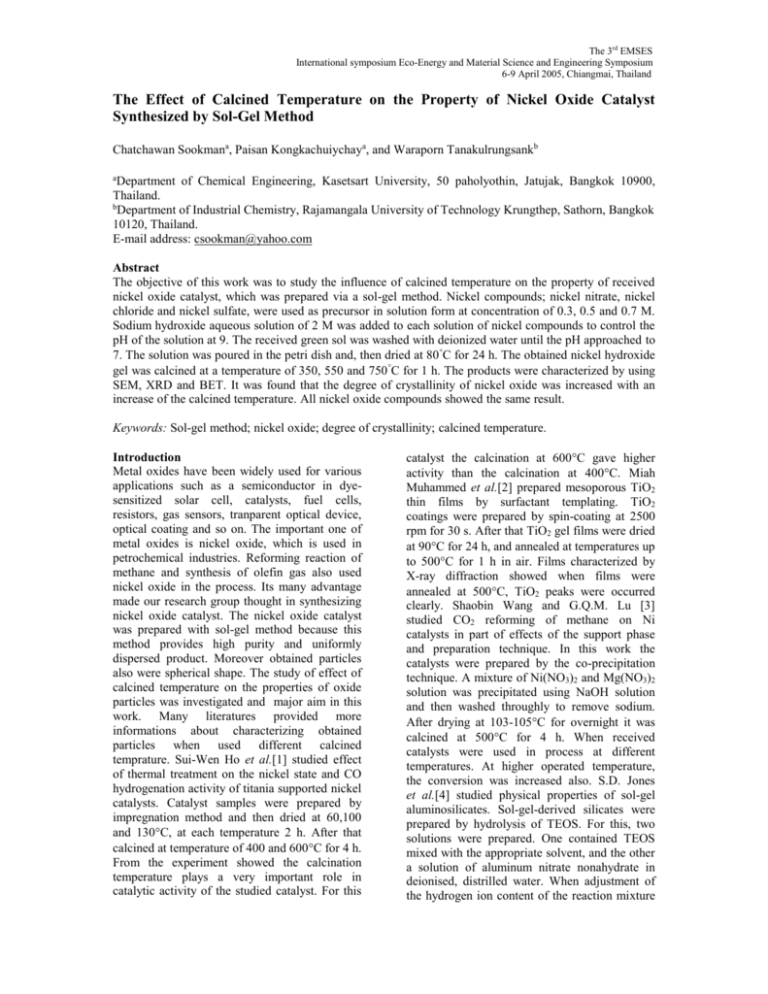
The 3rd EMSES International symposium Eco-Energy and Material Science and Engineering Symposium 6-9 April 2005, Chiangmai, Thailand The Effect of Calcined Temperature on the Property of Nickel Oxide Catalyst Synthesized by Sol-Gel Method Chatchawan Sookmana, Paisan Kongkachuiychaya, and Waraporn Tanakulrungsankb a Department of Chemical Engineering, Kasetsart University, 50 paholyothin, Jatujak, Bangkok 10900, Thailand. b Department of Industrial Chemistry, Rajamangala University of Technology Krungthep, Sathorn, Bangkok 10120, Thailand. E-mail address: csookman@yahoo.com Abstract The objective of this work was to study the influence of calcined temperature on the property of received nickel oxide catalyst, which was prepared via a sol-gel method. Nickel compounds; nickel nitrate, nickel chloride and nickel sulfate, were used as precursor in solution form at concentration of 0.3, 0.5 and 0.7 M. Sodium hydroxide aqueous solution of 2 M was added to each solution of nickel compounds to control the pH of the solution at 9. The received green sol was washed with deionized water until the pH approached to 7. The solution was poured in the petri dish and, then dried at 80 C for 24 h. The obtained nickel hydroxide gel was calcined at a temperature of 350, 550 and 750 C for 1 h. The products were characterized by using SEM, XRD and BET. It was found that the degree of crystallinity of nickel oxide was increased with an increase of the calcined temperature. All nickel oxide compounds showed the same result. Keywords: Sol-gel method; nickel oxide; degree of crystallinity; calcined temperature. Introduction Metal oxides have been widely used for various applications such as a semiconductor in dyesensitized solar cell, catalysts, fuel cells, resistors, gas sensors, tranparent optical device, optical coating and so on. The important one of metal oxides is nickel oxide, which is used in petrochemical industries. Reforming reaction of methane and synthesis of olefin gas also used nickel oxide in the process. Its many advantage made our research group thought in synthesizing nickel oxide catalyst. The nickel oxide catalyst was prepared with sol-gel method because this method provides high purity and uniformly dispersed product. Moreover obtained particles also were spherical shape. The study of effect of calcined temperature on the properties of oxide particles was investigated and major aim in this work. Many literatures provided more informations about characterizing obtained particles when used different calcined temprature. Sui-Wen Ho et al.[1] studied effect of thermal treatment on the nickel state and CO hydrogenation activity of titania supported nickel catalysts. Catalyst samples were prepared by impregnation method and then dried at 60,100 and 130C, at each temperature 2 h. After that calcined at temperature of 400 and 600C for 4 h. From the experiment showed the calcination temperature plays a very important role in catalytic activity of the studied catalyst. For this catalyst the calcination at 600C gave higher activity than the calcination at 400C. Miah Muhammed et al.[2] prepared mesoporous TiO2 thin films by surfactant templating. TiO2 coatings were prepared by spin-coating at 2500 rpm for 30 s. After that TiO2 gel films were dried at 90C for 24 h, and annealed at temperatures up to 500C for 1 h in air. Films characterized by X-ray diffraction showed when films were annealed at 500C, TiO2 peaks were occurred clearly. Shaobin Wang and G.Q.M. Lu [3] studied CO2 reforming of methane on Ni catalysts in part of effects of the support phase and preparation technique. In this work the catalysts were prepared by the co-precipitation technique. A mixture of Ni(NO3)2 and Mg(NO3)2 solution was precipitated using NaOH solution and then washed throughly to remove sodium. After drying at 103-105C for overnight it was calcined at 500C for 4 h. When received catalysts were used in process at different temperatures. At higher operated temperature, the conversion was increased also. S.D. Jones et al.[4] studied physical properties of sol-gel aluminosilicates. Sol-gel-derived silicates were prepared by hydrolysis of TEOS. For this, two solutions were prepared. One contained TEOS mixed with the appropriate solvent, and the other a solution of aluminum nitrate nonahydrate in deionised, distrilled water. When adjustment of the hydrogen ion content of the reaction mixture The 3rd EMSES International symposium Eco-Energy and Material Science and Engineering Symposium 6-9 April 2005, Chiangmai, Thailand was necessary, either nitric acid or ammonium hydroxide were added to the aqueous solution. Hydrolysis was performed by mixing the above two solutions under continuous stirring at 298 K in a water bath. For the systematic study of the relationship between preparation conditions and silicate pore structure, ratios of the reactants to silicon were used. These were molar ratios in the case of water, acid and aluminium and volume ratios in the case of the solvents used. Before calcination the sols were kept at ambient conditions for two days. Conversion to their oxides used a fixed thermal cycle where only the limiting temperature was changed and heating and cooling rates kept constant. This thermal cycle used ramp rates of 10C/h and a 4 h dwell period at the limiting temperature. When calcination temperature was varied at temperature of 473, 673 and 873 K, surface areas from BET analysis decreased with an increase of calcination temperature. Guo-Jun Li et al.[5] done synthesis of nickel nanoparticles dispersed in -alumina by heterogeneous precipitation. -Al2O3-Ni composite powders were prepared using NiO, Al(NO3)39H2O and NH3H2O as starting materials. Mixed solution was stirred until pH approach to 9,then obtained precipitates were filtered and thoroughly washed three times with distilled water. Finally, the precipitates were calcined in air at 700 and 900C for 2 h at a heating rate of 5C/min and the samples were calcined at 900C and reduced at 700C for 4 h in a hydrogen atmosphere at a heating rate of 5C/min. From the experiment, the crystal size increased with an increase of calcination temperature. Experimental The received nickel oxide catalysts prepared by sol-gel method under base catalyzed systems. The analytical grade reagents: Ni(NO3)26H2O, NiSO46H2O, NiCl26H2O, NaOH and KOH were used to prepared oxide particles. The nickel compounds were varied concentration of 0.3, 0.5 and 0.7 M. After that 2 M of base, NaOH and KOH, was added dropwise to each nickel compounds solution and stirred continuously until pH approach to 9. The green precipitate was separated from the mother liquor. Then the slurry was washed with deionized water until pH was about 7 for dispose of impurity ions. After dried at 80C for 24 h, the nickel hydroxide gel was occurred following ionic equation (1). Ni2+ + OH- = Ni(OH)2 (1) When nickel hydroxide gel was calcined at temperature of 350, 550 and 750 C for 1h, nickel oxide particles were obtained follow equation (2). Ni(OH)2 NiO (2) Characterization Powder X-ray diffraction (XRD) was measured on a PHILIPS XRD PW 1830 using Cu K radiation. Morphologies of the particles were observed by JEOL Scanning Electron Microscope. The BET surface areas were calculated by the BET-multipoint method. Results and discussion The oxide particles obtained from calcining at temperature of 350, 550 and 750C were grayblack powders. From X-ray diffraction analysis (a) (b) Fig. 1. XRD patterns of NiO particles obtained from 0.7 M of nickel nitrate and calcined at temperature of 350, 550 and 750C for 1h. (a) and (b) are XRD patterns of NiO particles obtained by using NaOH and KOH respectively. in Fig. 1(a) and (b) showed the crystal phase of NiO, which was observed from three main peaks at 2 theta about 38, 43 and 62.5. While NiO The 3rd EMSES International symposium Eco-Energy and Material Science and Engineering Symposium 6-9 April 2005, Chiangmai, Thailand crystal received from using NaOH gave NiO peaks having higher intensity than another.Moreover degree of crystallinity was increased with an increase of calcination temperture, in Fig. 1. At 750C the NiO crystal has the largest size when compared to other temperatures. Because at higher temperature the crystal has higher energy for growing. In Fig. 2. Showed SEM microphotographs, the obtained oxide particles synthesized at temperature of 750C gave spherical shape and good dispersion in two cases. Table 1 BET surface area of products calcined at 750C. Type of Ni compounds 0.7 M of Ni(NO3)2 0.7 M of NiCl2 0.7 M of NiSO4 base NaOH KOH NaOH KOH NaOH KOH Calcined temperature , C 750 750 750 Surface area, m2/g 5.5 5.4 5.4 5.2 3.1 2.9 Conclusion The degree of crystallinity of nickel oxide was increased with an increase of calcination temperature, and NiO peaks obtained by using NaOH gave higher intensity in all cases. To compare the received oxide particles size showed NiO synthesized by using NaOH provided a good uniformly spherical shape. And the average pore size of oxide particles was in range of macropore in all cases. Acknowledgements This work was supported by Rajamangala University of Technology Krungthep and Centers of Excellence of Thailand Commission of Higher Education, sponsored by ChE-ADB Program, Department of Chemical Engineering, Kasetsart University. Fig. 2. SEM microphotographs of NiO catalysts obtained from 0.7 M of nickel nitrate and calcined at temperature of 350, 550 and 750C for 1h. Left and right side are NiO particles synthesized by using NaOH and KOH respectively. While NiO particles obtained by using NaOH gave particle size having uniformly dispersed. For the results of BET analysis showed in table 1, NiO particles prepared by using NaOH provided a few higher surface area than another. And the average pore size of oxide particles in all cases was in range of macropore. References 1. Sui-Wen Ho, Chih-Yang Chu, and Shih-Guan Chen, “Effect of Thermal Treatment on the Nickel State and CO Hydrogenation Activity of Titania Supported Nickel Catalysts”, J. Catal.,34 (1998) 178. 2. M.M. Yusuf, H. Imai, and H. Hirashima, “Preparation of Mesoporous TiO2 Thin Films by Surfactant Templating”, J. Non-crystalline Solids,285 (2001) 90-95. 3. S. Wang and G.Q.M. Lu, “CO2 Reforming of Methane on Ni Catalysts: Effects of the Support Phase and Preparation Technique”, Applied Catalysis B: Environmental, 16 (1998) 269-277. 4. S.D. Jones, T.N. Pritchard, and D.F. Lander, “Physical Properties of Sol-Gel Aluminosilicates”, Microporous Materials, 3 (1995) 419-431. 5. Guo-Jun Li, Xiao-Xian Huang, Meiling Ruan, and Jing-Kun Guo, “Synthesis of Nickel Nanoparticles Dispersed in -Alumina by Heterogeneous Precipitation”, Ceramics International, 28 (2002) 165-169.

